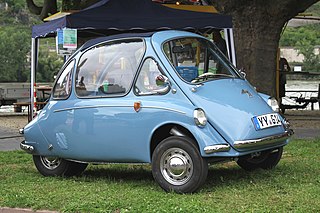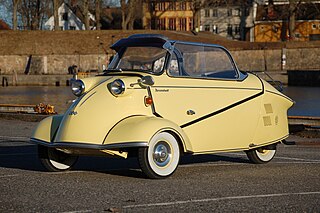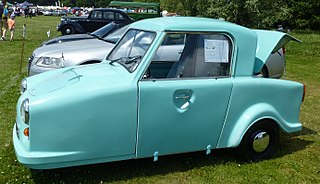
The Fend Flitzer was a three-wheeled invalid carriage designed and built by Fritz Fend. The Flitzer established many of the basic concepts on which Fend's later Messerschmitt Kabinenroller microcars were developed.

The Fend Flitzer was a three-wheeled invalid carriage designed and built by Fritz Fend. The Flitzer established many of the basic concepts on which Fend's later Messerschmitt Kabinenroller microcars were developed.
In 1948, Fend, a former aeronautical engineer and technical officer in the Luftwaffe, [1] began production of a tricycle invalid carriage in his workshop in Rosenheim, Germany. [2] [3] [4] The tricycle had a front wheel that was steered by handlebars and powered by a mechanism actuated by pushing back and forth on the handlebars. Shortly afterward, it was offered with a 38 cc (2.3 cu in) Victoria two-stroke proprietary engine normally used for motorizing bicycles. [2]
Fend then designed the Flitzer, a larger, better-enclosed invalid carriage. It was designed from the start to be powered by a gasoline engine. Whereas the earlier tricycle was both steered and powered by a single front wheel, the Flitzer had a pair of front wheels linked to the steering mechanism and a powered rear wheel. [2]

The Flitzer was made with aluminium panels over a steel frame [2] and was enclosed at the front, sides, and back.[ citation needed ] It had a hatch at the top that was hinged at the front and tilted forward for the operator to get in. [2] The first version of the Flitzer was open, with a hole and a windshield in the hatch for the operator's head and shoulders to stick through and be protected from the wind.[ citation needed ] Flitzers made from September 1948 into 1950 [3] were powered by a 98 cc (6.0 cu in) Fichtel & Sachs two-stroke engine. [2] [3] [4] Suspension was by rubber springs loaded in torsion. [2]
In 1950 the engine was changed to a 100 cc (6.1 cu in) Riedel/Imme engine. [2] [3] [4] By 1951, in response to customer requests for passenger-carrying capability, a scooter-type saddle was placed above the rear enclosure with footrests on either side of the body. [2] A closed version, on which the hatch had an enclosure that covered the operator, was made available. The enclosure included the windshield and side windows. [2] [3]

About 250 Flitzers had been built when production stopped in 1951. Many of these invalid carriages had been bought by able-bodied individuals seeking basic personal transport. [2] This led Fend to believe that there would be a mass market for a larger, transport-oriented version of the Flitzer. [5] Fend began to design and develop a two-seat vehicle similar in concept to the Flitzer. [3] He also began looking for a manufacturer to mass-produce this vehicle. He came to an agreement with Messerschmitt for them to build Fend vehicles in their factory at Regensburg [3] [5] Part of the agreement was that the cars carried the Messerschmitt name, with Fend's new design being designated the Messerschmitt KR175. [3] [6]

A tricycle, sometimes abbreviated to trike, is a human-powered three-wheeled vehicle.

Heinkel Flugzeugwerke was a German aircraft manufacturing company founded by and named after Ernst Heinkel. It is noted for producing bomber aircraft for the Luftwaffe in World War II and for important contributions to high-speed flight, with the pioneering examples of a successful liquid-fueled rocket and a turbojet-powered aircraft in aviation history, with both Heinkel designs' first flights occurring shortly before the outbreak of World War II in Europe.

Microcar is a term often used for the smallest size of cars, with three or four wheels and often an engine smaller than 700 cc (43 cu in). Specific types of microcars include bubble cars, cycle cars, invacar, quadricycles and voiturettes. Microcars are often covered by separate regulations to normal cars, having relaxed requirements for registration and licensing.

The Messerschmitt KR200, or Kabinenroller, is a three-wheeled bubble car designed by the aircraft engineer Fritz Fend and produced in the factory of the German aircraft manufacturer Messerschmitt from 1955 until 1964.

The Vulcan name has been used by Kawasaki for their custom or touring bike since 1984, model designation VN, using mostly V-twin engines ranging from 125 to 2,053 cc.

The Messerschmitt Kabinenroller was a series of microcars made by RSM Messerschmitt from 1953 to 1956 and by Fahrzeug- und Maschinenbau GmbH, Regensburg (FMR) from 1956 to 1964. All the Messerschmitt and FMR production cars used the Kabinenroller's monocoque structure, featuring tandem seating and usually a bubble canopy.

The FMR Tg500 was a sports car built by Fahrzeug- und Maschinenbau GmbH, Regensburg (FMR) from 1958 to 1961. Based on the Messerschmitt Kabinenroller monocoque, which otherwise was a platform for three-wheelers, the Tg500 was a four-wheeled car with a two-stroke straight-two engine. FMR had taken over production of the KR200 from Messerschmitt in 1956. While the KR200 still used the Messerschmitt name and logo, the Tg500 was badged as an FMR.

The Messerschmitt KR175 microcar (1953–1955) was the first vehicle built by Messerschmitt under its 1952 agreement with Fritz Fend. In concept, although not in actual design, it was, in principle, a development of the Fend Flitzer invalid carriage. Approximately 15,000 were built before it was replaced by the Messerschmitt KR200 in 1956.

A motorized bicycle is a bicycle with an attached motor or engine and transmission used either to power the vehicle unassisted, or to assist with pedalling. Since it sometimes retains both pedals and a discrete connected drive for rider-powered propulsion, the motorized bicycle is in technical terms a true bicycle, albeit a power-assisted one. Typically they are incapable of speeds above 52 km/h (32 mph).

The Invacar was a small single-seater microcar vehicle designed for use by disabled drivers, and distributed for free in the UK.

A handcycle is a type of human-powered land vehicle powered by the arms rather than the legs, as on a bicycle. Most handcycles are tricycle in form, with two coasting rear wheels and one steerable powered front wheel. Despite usually having three wheels, they are also known as handbikes.
Fritz Fend was an aeronautical engineer. He was noted for designing Messerschmitt's Kabinenroller (cabinscooter) KR175 and KR200 microcars, for co-founding FMR, the company that took over production of the Kabinenrollers in 1956, and for designing the FMR Tg500, a sports microcar based on the Kabinenroller. Fend continued his career as an inventor and designer after the KR200 ended production. Fend was working on another lightweight vehicle project shortly before his death.

Arola SARL was a small manufacturing company based in Lyon-Corbas, France, which manufactured a range of microcars, designed to be driven without a license. Arola became part of the Aixam group in 1983.

A scooter is a motorcycle with an underbone or step-through frame, a seat, and a platform for the rider's feet, emphasizing comfort and fuel economy. Elements of scooter design were present in some of the earliest motorcycles, and motor scooters have been made since at least 1914.

The Imme R100 was a lightweight motorcycle made by Riedel AG from 1948 to 1951. It is noted for its simple and innovative design with many advanced features. With low cost and technical innovation, the R100 sold well, but reliability problems and low profit margins resulted in warranty costs driving Riedel AG into bankruptcy.

Invalid carriages were usually single seater road vehicles, buggies, or self-propelled vehicles for disabled people. They pre-dated modern electric mobility scooters and, from the 1920s, were generally powered by small gasoline/petrol engines, although some were battery powered. They were usually designed without foot-operated controls.
SEAB (Societe d'Exploitation et d'Application des Brevet) was a manufacturer of plastic asr bodies and microcars. It was located in Villejuif, Paris.
Maquinaria y Elementos de Transporte, also known as Maquitrans or by the abbreviation MT is a former bus modification and Spanish car manufacturer based in Barcelona.